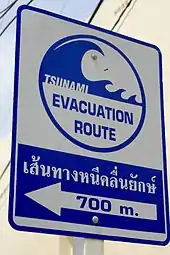Vertical and horizontal evacuation
Vertical and horizontal evacuation are strategies for providing safety to humans in case of tsunami, hurricane or other natural disaster.[1]

Vertical evacuation

In areas where horizontal evacuation to higher ground is impossible, vertical evacuation to higher areas of a structure may be a way to shelter individuals from the surge of water, several meters high, that can follow an earthquake in coastal areas.[2][3]
In the United States
The U.S. Federal Emergency Management Agency published design guidelines for vertical evacuation structures in 2008.[4] According to the American Society of Mechanical Engineers, serious discussions about vertical evacuation began in the United States following the 2011 Tōhoku earthquake and tsunami.[5] The American Society of Civil Engineers adopted an updated edition of its building standards in September 2016, including tsunami hazards for the first time.[6]
The first vertical evacuation site in the United States was Ocosta Elementary School, constructed in 2015–2016 on the Pacific Ocean coast in Westport, Washington, where a Cascadia subduction zone magnitude 9+ earthquake is expected to cause great tsunamis.[7][8]
Horizontal evacuation

An alternative to vertical evacuation is horizontal evacuation, for instance a hurricane evacuation route. Critics of vertical evacuation planning have charged it with justifying even greater human density in areas prone to disaster, and prefer low density growth with horizontal evacuation planning.[9]
See also
References
- Penuel & Statler 2010, p. 186-188.
- Penuel & Statler 2010, p. 186.
- Tsunami Hazard Mitigation Program 2001, p. 47.
- Guidelines for Design of Structures for Vertical Evacuation from Tsunamis, Federal Emergency Management Agency, June 2008, FEMA P646 (updated 2012)
- Michael MacRae (April 2011), Tsunami Forces Debate over Vertical Evacuation, American Society of Mechanical Engineers
- Civil engineering society issues first-ever tsunami-safe building standards, Oregon State University, September 28, 2016, retrieved February 2, 2017
- CREW 2013.
- Breaking new ground on nation's first tsunami vertical evacuation site, Washington Military Department, January 16, 2015
- Beatley, Brower & Schwab 2002, p. 68.
Bibliography
- Beatley, Timothy; Brower, David; Schwab, Anna K. (2002), "Coastal pressures and critical management issues", An Introduction to Coastal Zone Management (Second ed.), Island Press, ISBN 9781559639156
- "Vertical evacuation and other strategies", Cascadia Subduction Zone Earthquakes: A Magnitude 9..0 Earthquake Scenario (PDF) (2013 update ed.), Cascadia Region Earthquake Workgroup (CREW), 2013, p. 22
- Designing for Tsunamis, National Tsunami Hazard Mitigation Program (NOAA, FEMA, USGS, Alaska, California, Hawaii, Oregon, Washington State), March 2001
- Penuel, K. Bradley; Statler, Matt, eds. (2010), "Evacuation, types of", Encyclopedia of Disaster Relief, SAGE Publications, ISBN 9781452266398,
The term vertical evacuation refers to a social process where agents relocate from one threatened area to an upper area or areas of the same physical structure.
Further reading
- Ruch, Carlton E., ed. (1991), The Feasibility of Vertical Evacuation: Behavioral, Legal, Political, and Structural Considerations, Volume 52 of Program on environment and behavior, Institute of Behavirol Science, University of Colorado, ISBN 9781877943058